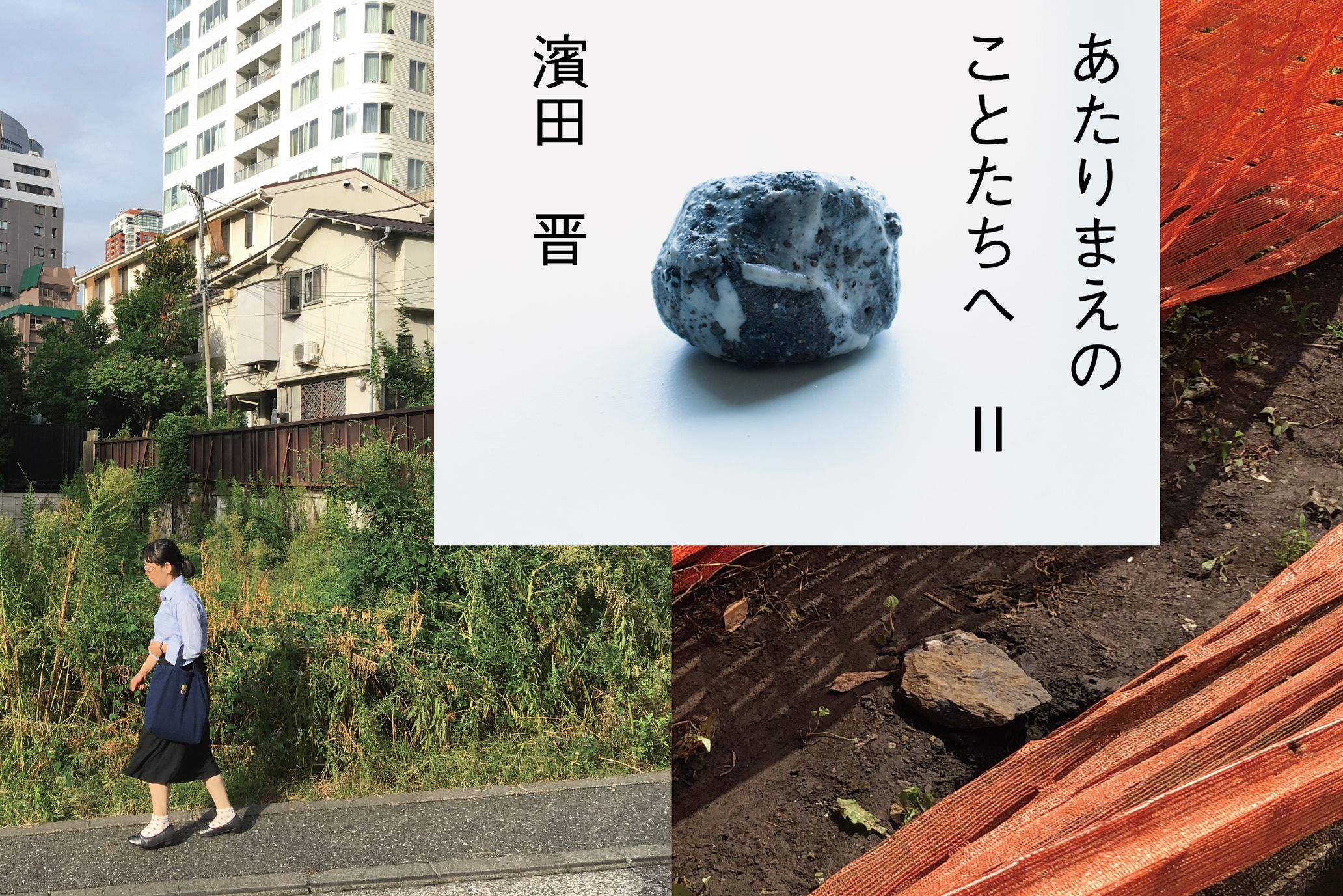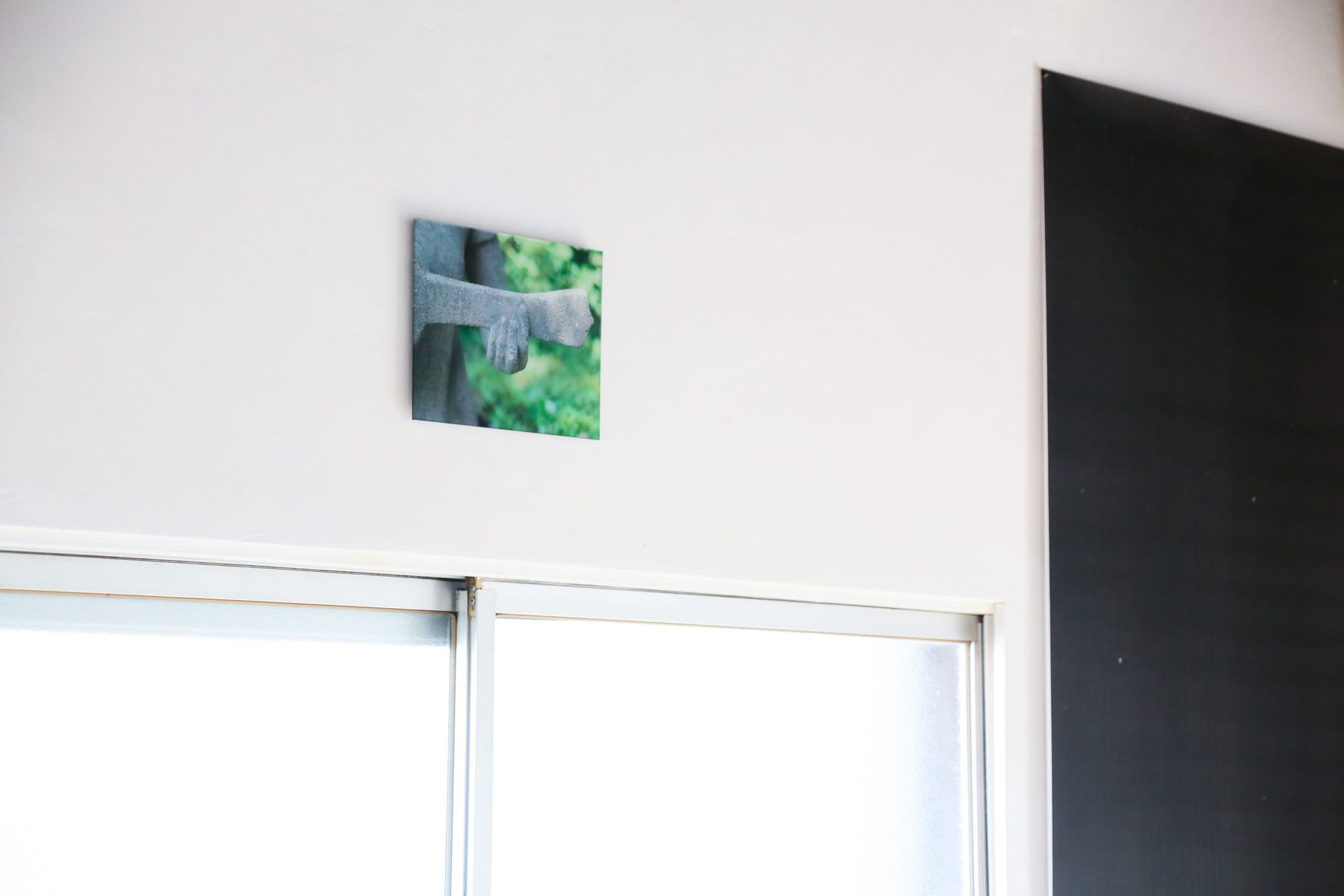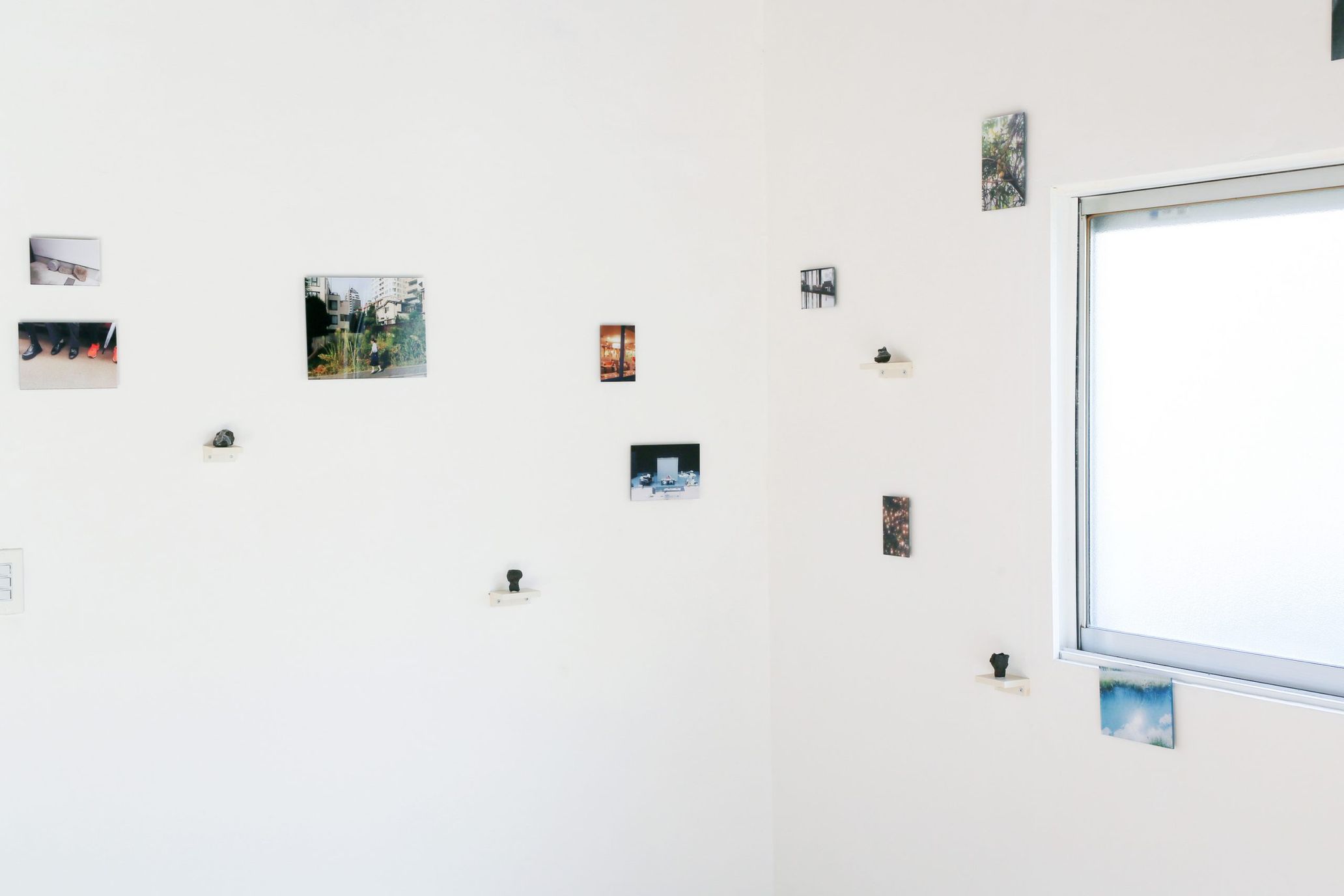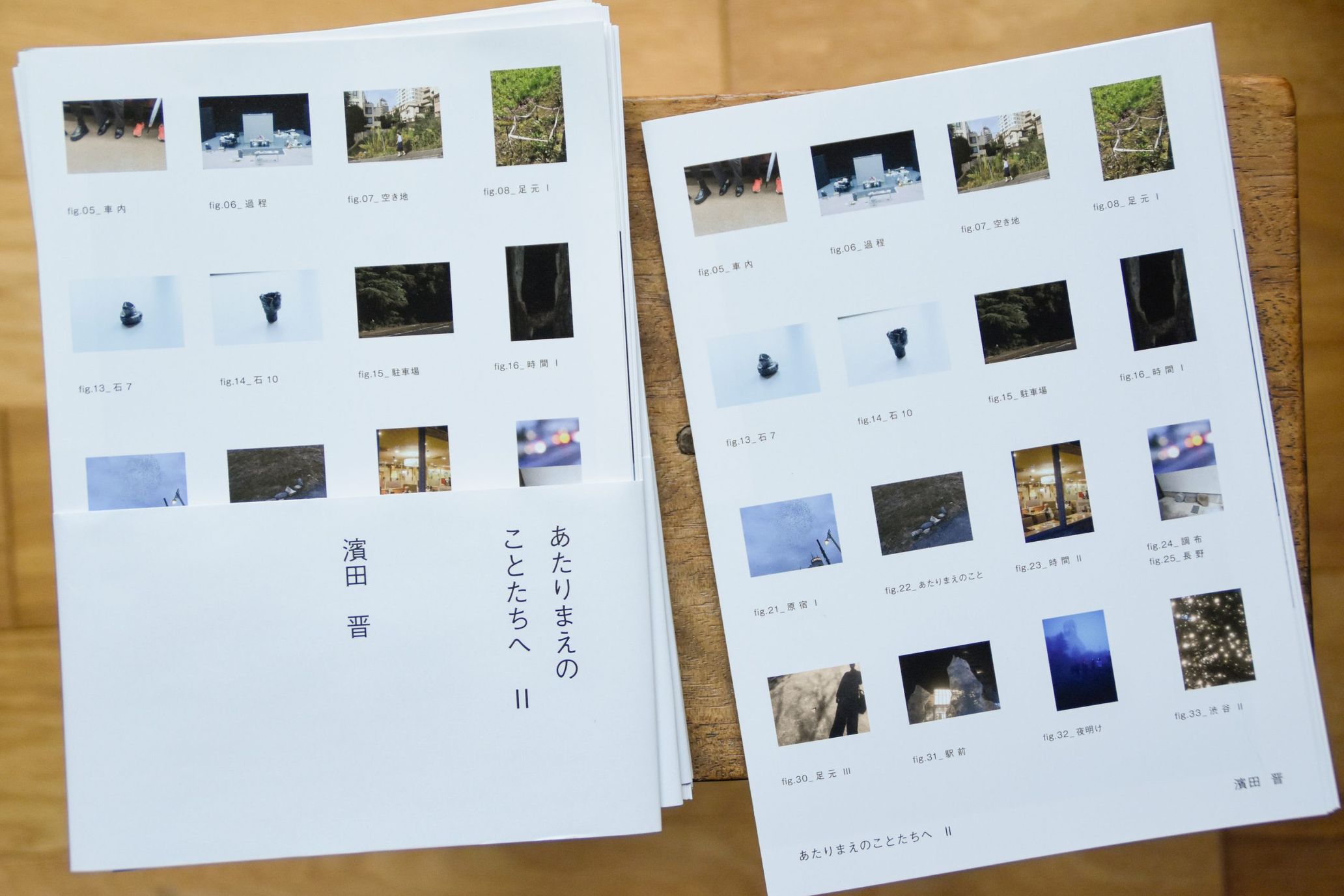Shin Hamada is a photographer who plays an active role mainly in the fields of portrait photography and documentary. Hamada states: “The act of taking photos mirrors the attitude of living”—and without being strictly adherent to any specific motifs or techniques, he captures the array of buildings under the fairly light sky, the interior of a family restaurant, pebbles lying at the feet, and other insouciant sceneries of everyday life. atarimae・no・kototachie II was the second version of atarimae・no・kototachie held at On Sundays in 2019; and his new 3D ceramic-like art piece called “Ishi (Stone)” and photographs were showcased. There is a certain lightness in his works that allows the viewers to trace their memories. On the other hand, Hamada is merely trying to update his surroundings by continuously practicing his ‘natural thing (atarimae・no・koto)’, which for him is to take photographs—The critic from Iwate Museum of Art, Natsuki Iwadare, unravels such artist’s artistic identity.
The exhibition atarimae・no・kototachie II was comprised of acrylic photo prints, large monochrome scenery photographs, and pebble-like 3D artwork. It was breathtaking seeing these crafts showcased in the gallery full of natural light, but as I gazed at them, I began to experience the uncanny sensation as if my feet were not touching the ground and I was levitating. Normally and especially at a ‘solo-exhibition’, I look for the artist’s coherent principle or manifestation, and intention. In other words, I’m trying to find the artist’s presence in the works. However, this time, when I peered around the gallery, I could not discern the artist Hamada’s viewpoint to the world. And this ‘elusiveness’ was exactly my impression of Hamada himself. But I also felt that I was finally able to grasp that ‘something’ we have been failing to reach when accepting things.
Hamada refers the act of taking photographs as ‘gleaning’. When shooting, he does not care to adjust the composition and lighting, and his gears are eclectic that at times he uses his smartphone or SLR camera that he happens to own. Regarding his photographs, he does not aim for well-balanced picturesque images, but he would rather relentlessly capture every moment in sight. It seems as if he is collecting small stones that are nothing special lying in the streets. There is no apparent purpose or meaning, and shooting is only a part of his daily deeds. Hence, the array of his photographs are replicas of his everyday life, and consequences of his primitive conduct like breathing air.
This can be said for his small sculpture titled “Ishi (Stone)”. Near Hamada’s resident, there is a pottery studio where he sometimes visits; and that is where he rendered his sculpture “Ishi”. And the shape of the masterpiece was coincidently formed as he was playfully kneading the clay while conversing with the owner of the studio. The sculpture was obviously handmade by Hamada, however, there is no characterized context in it, and it is in fact nothing more than a relic from his brief time spent in the pottery studio. My impression when I saw “Ishi” at the gallery is that it is the artist’s ‘excretion’. Of course, I don’t mean it in an ironic way. The sculpture was born in the extension of an individual human’s ‘natural thing (atarimae・no・koto)’ just like ‘eating’, ‘moving’, and ‘sleeping’.
Also, it is extremely interesting that the title of the exhibition was referenced from the theme of work handled by Sadaharu Horio, who used to be a member of the Gutai Art Association. Hamada’s home in Hyogo prefecture and Horio’s home happen to be close to each other, that there were times they interacted. One of the challenges that Sadaharu Horio as an artist seeks to achieve is to portray the ‘air’ that is invisible yet exits as a ‘normal thing’, and he keeps up the habit of coloring daily commodities everyday※. The slew of his artworks, that is the accumulation from his daily habitual activities, obtains great energy that it is at times daunting. The whole process is requisite for Horio as an artist to affirm and accept his existence, as well as to fulfill his obsession to feel ‘alive’.
Hamada’s works are created through practicing the ‘natural thing’ in everyday life, which is in common with Horio’s works. However, how Horio defines ‘himself’ through the action of perpetually layering paints, is something that cannot be seen with Hamada’s works. Although Hamada’s photographs and “Ishi” are made by his own hands, his presence disappears from the moment he hits the shutter or releases his hands from the sculpture. Photographs are the ‘eyes’ of the photographer—and photographers procure originality for their works as they carry out their ‘intention’ to cut out the subject by finessing the composition, lighting, and color balance. And most of the time, with any photographs, the photographer’s moderately devised ‘intention’ or in other words, a piece of their presence can be found. Nevertheless, because Hamada does not press the shutter with the ‘intention’, his presence is hard to perceive in his photographs. Even with “Ishi”, he claims that he avoided to have a specific purpose when making its shape and aimed to make ‘something that has no meaning’. Hamada’s artworks at this exhibition are created in the moment of capturing the scenery that came into his sight, or casually forming a three-dimensional shape with clay; and there is not a single mark of ‘himself’ left behind in the works even though his presence is certain. Simply his subjects are ‘things that happen to be there’, and his collection is a documentation of them.
When we see things, we tend to define them in any way. If the subject is an art piece, it lures us to find out ‘what it’s trying to convey’, and if it is a media of photography, we naturally observe the details of the photos concerning the photographer’s perspective—such as ‘this photo is showing the people living strongly even in the war zone’ or ‘this photo is revealing sexuality that lurks in the flowers’. Though, the perspective of the photographer that the viewers often recognize is absent in Hamada’s works, and his works solely show the presences of the subjects. A family restaurant at night, a parking lot in a dilapidated lush forest, legs of people sitting on the opposite side in a train—these scenes in the photos obtain a certain universality that they can be converted and appear as ‘a familiar scenery’ to anyone. Such works are achieved by the absence or ‘elusiveness’ of the artist, being emancipated from meanings and definitions, and showcasing bona fide appearances of the things.
In the world we live in, there are things that cannot be explained thoroughly by logic or words. But by Hamada’s ‘elusiveness’ exuded in this exhibition, we can feel that ‘something’ in its authentic self. And I presume that ‘something’ is very close to the marrow of the world.
※Shingo Mitsui / Yuki Teshiba.“Interview 03/Sadaharu Horio”. KOBE ART MARCHÉ. https://www.art-marche.jp/interview/03/
Shin Hamada
Born in 1987 in Hyogo prefecture. While he mainly shoots in the fields of portraiture, documentary, and coverages, he fuses his photographies, captured with the concept of ‘gleaning the undefinable ordinary’, with three-dimensional artworks, texts, and various means of expression. He puts his effort into making zine; and his lifework zine CHILL! series has been ongoing for over 10 years.
shinhamada.com
Instagram:@shinhamadastudio










